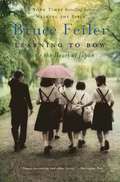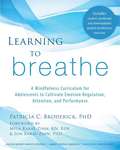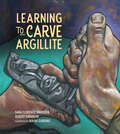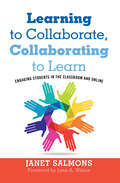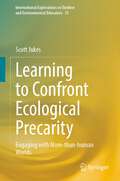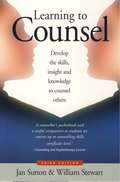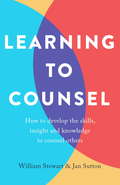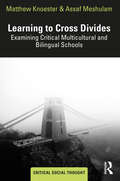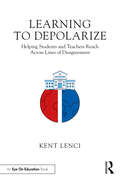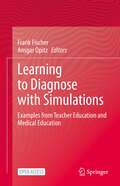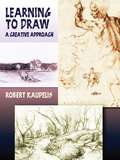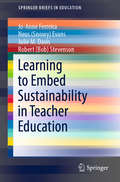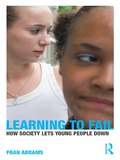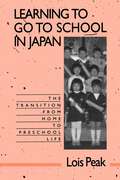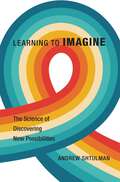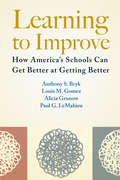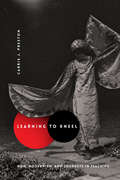- Table View
- List View
Learning to Bow
by Bruce FeilerLearning to Bow has been heralded as one of the funniest, liveliest, and most insightful books ever written about the clash of cultures between America and Japan. With warmth and candor, Bruce Feiler recounts the year he spent as a teacher in a small rural town. Beginning with a ritual outdoor bath and culminating in an all-night trek to the top of Mt. Fuji, Feiler teaches his students about American culture, while they teach him everything from how to properly address an envelope to how to date a Japanese girl.
Learning to Bow
by Bruce FeilerLearning to Bow has been heralded as one of the funniest, liveliest, and most insightful books ever written about the clash of cultures between America and Japan. With warmth and candor, Bruce Feiler recounts the year he spent as a teacher in a small rural town. Beginning with a ritual outdoor bath and culminating in an all-night trek to the top of Mt. Fuji, Feiler teaches his students about American culture, while they teach him everything from how to properly address an envelope to how to date a Japanese girl.
Learning To Breathe: A Mindfulness Curriculum For Adolescents To Cultivate Emotion Regulation, Attention, And Performance
by Patricia Broderick Myla Kabat-Zinn Jon Kabat-ZinnDisruptive behavior in the classroom, poor academic performance, out-of-control emotions: if you work with adolescents, you are well-aware of the challenges this age group presents. What if there was a way to calm these students down and arm them with the mindfulness skills needed to really excel in school and life? <p><p> Written by mindfulness expert and licensed clinical psychologist Patricia C. Broderick, Learning to Breathe is a secular program that tailors the teaching of mindfulness to the developmental needs of adolescents to help them understand their thoughts and feelings and manage distressing emotions. Students will be empowered by learning important mindfulness meditation skills that help them improve emotion regulation, reduce stress, improve overall performance, and, perhaps most importantly, develop their attention. The book also includes a website link with student handouts and homework assignments, making it an ideal classroom tool. <p> The book integrates certain themes of mindfulness-based stress reduction (MBSR), developed by Jon Kabat-Zinn, into a program that is shorter, more accessible to students, and compatible with school curricula. Students will learn to pay attention in the moment, manage emotions as they are perceived, and gain greater control over their own feelings and actions. These mindfulness practices offer the opportunity to develop hardiness in the face of uncomfortable feelings that otherwise might provoke a response that could be harmful (e.g. acting out by taking drugs, displaying violent behavior or acting in by becoming more depressed). <p> This easy-to-use manual is designed to be used by teachers, but can also be used by any mental health provider teaching adolescents emotion regulation, stress reduction and mindfulness skills. The author is a graduate of the MBSR advanced practicum at the Center for Mindfulness in Massachusetts, led by Jon Kabat-Zinn. She is also a clinical psychologist and a certified school psychologist and counselor for grades K-12. In the book, Broderick calls on her years of experience working with adolescents to outline the best strategies for dealing with disruption in the classroom and emotions that are out of hand. <p> The book is structured around six themes built upon the acronym BREATHE, and each theme has a core message. The program allows for themes to be delivered in 6 longer or 18 shorter sessions, depending upon time and needs of students. The 6 core lessons are: Body, Reflection, Emotions, Attention, Tenderness, and Healthy Mind Habits. <p> Learning to Breathe is the perfect tool for empowering students as they grapple with the psychological tasks of adolescence.
Learning to Carve Argillite (Sk'ad'a Stories Series)
by Sara Florence Davidson Robert DavidsonBased on Haida artist Robert Davidson's own childhood experiences, this beautiful story highlights learning through observation, as well as the role of Elders in sharing knowledge and mentorship.Learning to carve is a lifelong journey. With the help of his father and grandfather, a boy on Haida Gwaii practises to become a skillful carver. As he carefully works on a new piece, he remembers a trip to Slatechuck Mountain to gather the argillite, as well as his father&’s words about the importance of looking back to help us find our way.Written by the creators of Potlatch as Pedagogy, this book brings the Sk'ad'a Principles to life through the art of Janine Gibbons.
Learning to Carve Argillite (Sk'ad'a Stories Series)
by Sara Florence Davidson Robert DavidsonBased on Haida artist Robert Davidson's own childhood experiences, this beautiful story highlights learning through observation, as well as the role of Elders in sharing knowledge and mentorship.Learning to carve is a lifelong journey. With the help of his father and grandfather, a boy on Haida Gwaii practises to become a skillful carver. As he carefully works on a new piece, he remembers a trip to Slatechuck Mountain to gather the argillite, as well as his father&’s words about the importance of looking back to help us find our way.Written by the creators of Potlatch as Pedagogy, this book brings the Sk'ad'a Principles to life through the art of Janine Gibbons.
Learning to Change Lives
by A. Ka TsangThe Strategies and Skills Learning and Development (SSLD) system is an action-oriented model for enabling clients in social work, health, mental health, and human services settings to address their needs and life goals. In Learning to Change Lives, author A. Ka Tat Tsang introduces SSLD's powerful framework and practice, which has been developed based on three decades of experience in psychotherapy, counselling, education, training, consultation, and community service.Learning to Change Lives provides detailed, step-by-step guidelines for SSLD intervention - starting with engagement with the client, assessment, translating problems into intervention plans, systematic learning and development of appropriate strategies and skills. Key practice procedures are described clearly and illustrated by case examples, specific instructions, and sample worksheets. Aimed at clinical practitioners, mental health professionals, social workers, and other human service professionals, this book can be used as a manual by practitioners and as a textbook for courses and training programs.
Learning to Collaborate, Collaborating to Learn: Engaging Students in the Classroom and Online
by Janet SalmonsStudents who know how to collaborate successfully in the classroom will be better prepared for professional success in a world where we are expected to work well with others. Students learn collaboratively, and acquire the skills needed to organize and complete collaborative work, when they participate in thoughtfully-designed learning activities.Learning to Collaborate, Collaborating to Learn uses the author’s Taxonomy of Online Collaboration to illustrate levels of progressively more complex and integrated collaborative activities.- Part I introduces the Taxonomy of Online Collaboration and offers theoretical and research foundations.- Part II focuses on ways to use Taxonomy of Online Collaboration, including, clarifying roles and developing trust, communicating effectively, organizing project tasks and systems.- Part III offers ways to design collaborative learning activities, assignments or projects, and ways to fairly assess participants’ performance.Learning to Collaborate, Collaborating to Learn is a professional guide intended for faculty, curriculum planners, or instructional designers who want to design, teach, facilitate, and assess collaborative learning. The book covers the use of information and communication technology tools by collaborative partners who may or may not be co-located. As such, the book will be appropriate for all-online, blended learning, or conventional classrooms that infuse technology with “flipped” instructional techniques.
Learning to Confront Ecological Precarity: Engaging with More-than-human Worlds (International Explorations in Outdoor and Environmental Education #13)
by Scott JukesThis volume presents innovative approaches for confronting environmental issues and socio-ecological inequality within Outdoor Environmental Education (OEE). Through experimentation with alternative pedagogical possibilities, it explores what OEE can do in response to ecological precarity. Drawing upon posthumanist theory, it focuses on the enactment of more-than-human pedagogies that foster affirmative environmental relationships while challenging problematic cultural perspectives. The 12 chapters explore various topics, including place-responsive pedagogies, environmental stories, new materialist theoretical insights and waste education practices, engaging with complex environmental issues such as species extinction and climate change in the context of OEE. This book provides practical examples and conceptual creativity to extend contemporary theoretical currents. It offers innovative pedagogical strategies and methodological insights for OEE. Researchers, students, and practitioners of OEE interested in applying posthumanist ideas to their work will find this volume most interesting.
Learning To Counsel, 4th Edition: Develop The Skills, Insight And Knowledge To Counsel Others
by William Stewart Jan Suttonhe new edition of this popular and userfriendly book has been thoughtfully revised, updated and expanded. Fresh informationhas been added to keep pace with the rapidly advancing field of counselling and psychotherapy.Learning to Counsel, Third Edition, contains an abundance of illustrative graphics, case studies, examples of skills in practice, practical exercises, and sample letters, forms and checklists designed to stimulate learning. Its predecessor appears onthe recommended reading list of several counselling certificate courses.This new revised edition is an ideal text for those contemplating embarking on a counselling course, trainee counsellors, counselling tutors to use in training, professionals working in the area of health care, management, and education, and counsellors working in the voluntary sector.Contents: Illustrations, table, sample forms and letters; Foreword; Preface; 1. Exploring Counselling; 2. Exploring Essential Counsellor Qualities; 3. Developing Self-Awareness; 4. Helping the Client Feel Safe; 5. Helping the Client Explore the Problem (Part 1); 6. Helping the Client Explore the Problem (Part 2); 7. Helping the Client Understand the Problem; 8. Helping the Client Resolve the Problem; 9. Terminating the Counselling Relationship; 10. Counsellor Self-Care; Appendix 1 Sample Forms and Letters; Appendix 2 Suggested Responses to Exercises; Appendix 3 Important People in the Development of Counselling; Glossary; Useful Websites; Further Reading; Index.
Learning To Counsel, 4th Edition: How to develop the skills, insight and knowledge to counsel others
by William Stewart Jan SuttonDrawing on their numerous years experience as counsellors, tutors, and writers, Jan Sutton and William Stewart introduce readers to the basic principles that underpin counselling practice. Written in a clear, concise and jargon-free style, and with its wealth of case studies, examples of skills in practice, and practical exercises, this new edition is an ideal text for those embarking on a counselling or psychotherapy course, trainee counsellors, counselling tutors to use in training, professionals working in the area of health care, management and education, and counsellors working in the voluntary sector. It provides insight into various counselling approaches; clarifies the nature of counselling and the role of the counsellor, and assists readers to develop a repertoire of key counselling skills and qualities, such as active listening, genuineness, unconditional positive regard, empathy, goal-setting, etc. The book also addresses the important issues of ongoing supervision to enhance counselling practice, and counsellor self-care to reduce the risk of burnout.
Learning To Counsel, 4th Edition: How to develop the skills, insight and knowledge to counsel others
by Jan Sutton William StewartDrawing on their numerous years experience as counsellors, tutors, and writers, Jan Sutton and William Stewart introduce readers to the basic principles that underpin counselling practice. Written in a clear, concise and jargon-free style, and with its wealth of case studies, examples of skills in practice, and practical exercises, this new edition is an ideal text for those embarking on a counselling or psychotherapy course, trainee counsellors, counselling tutors to use in training, professionals working in the area of health care, management and education, and counsellors working in the voluntary sector. It provides insight into various counselling approaches; clarifies the nature of counselling and the role of the counsellor, and assists readers to develop a repertoire of key counselling skills and qualities, such as active listening, genuineness, unconditional positive regard, empathy, goal-setting, etc. The book also addresses the important issues of ongoing supervision to enhance counselling practice, and counsellor self-care to reduce the risk of burnout.
Learning to Cross Divides: Examining Critical Multicultural and Bilingual Schools (Critical Social Thought)
by Matthew Knoester Assaf MeshulamThis volume demonstrates how multilingual schooling can enhance democracy through a connection with the policies and practices of critical education. With its in-depth analysis of real schools that focus on the dual emphases of multiculturalism and integration, this book offers a comparative look at educational and political controversies over race, citizenship, and societal power relations. The authors describe the ambitious goals and critical multicultural and bilingual education strategies used at these schools, and, in doing so, they highlight how the challenges involved relate to larger theoretical issues that are inherent to a critically multicultural and bilingual education. This book examines what a truly critical multicultural and bilingual education means and what it requires of those who are intimately connected with these processes. As such, it will be important reading for those studying, teaching, or researching in Sociology of Education, Multicultural Education, Multilingual and Bilingual Education, Educational Policy, and Critical Education Studies.
Learning to Cross Divides: Examining Critical Multicultural and Bilingual Schools (Critical Social Thought)
by Matthew Knoester Assaf MeshulamThis volume demonstrates how multilingual schooling can enhance democracy through a connection with the policies and practices of critical education.With its in-depth analysis of real schools that focus on the dual emphases of multiculturalism and integration, this book offers a comparative look at educational and political controversies over race, citizenship, and societal power relations. The authors describe the ambitious goals and critical multicultural and bilingual education strategies used at these schools, and, in doing so, they highlight how the challenges involved relate to larger theoretical issues that are inherent to a critically multicultural and bilingual education.This book examines what a truly critical multicultural and bilingual education means and what it requires of those who are intimately connected with these processes. As such, it will be important reading for those studying, teaching, or researching in Sociology of Education, Multicultural Education, Multilingual and Bilingual Education, Educational Policy, and Critical Education Studies.
Learning to Depolarize: Helping Students and Teachers Reach Across Lines of Disagreement
by Kent LenciHow can schools shoulder some responsibility for depolarizing our fractured American society? In this provocative new book, Kent Lenci describes how educators can tackle the challenge of preparing students to communicate and collaborate across lines of deep disagreement—to face the political and ideological "other"—despite the conventional wisdom that schools should be apolitical. Topics covered include the causes and consequences of political polarization in our society, why schools must address the challenge head-on, bridge-building in the classroom, media literacy and social emotional learning as tools for depolarization, and partnering with parents across the divide. Each chapter offers current research as well as practical strategies and classroom anecdotes. Appropriate for teachers of all grade levels and subject areas, the book will help you reconsider your classroom and school’s role in forging a more depolarized future.
Learning to Diagnose with Simulations: Examples from Teacher Education and Medical Education
by Frank Fischer Ansgar OpitzThis open access book presents 8 novel approaches to measure and improve diagnostic competences with simulation. The book compares the effects of interventions on these diagnostic competences in both teacher and medical education. It includes analyses showing that important aspects of diagnostic competences and effects of instructional interventions aiming to facilitate them are comparable for teachers and doctors. Through closely analyzing projects from medical education, mathematics education, biology education, and psychology, the reader is presented with multiple options for interventions that may be used in each of the subject areas and the improvements in diagnostic skills that could be expected from each simulation. The book concludes with an outline of promising future research on the use of simulations to facilitate professional competences in higher education in general, and for the advancement of diagnostic competencies in particular.This is an open access book.
Learning to Draw: A Creative Approach (Dover Art Instruction)
by Robert KaupelisTeachers, students, and amateur artists will all benefit from the advice of this esteemed educator and fine artist whose book, as described by a colleague, is "a cause célèbre for art education, not only because it meets the urgent professional need, but also because it combines artistic, aesthetic, and instructional considerations in a way which is significantly different from any other text."Encouraging teachers and students to use his suggestions in ways they feel most appropriate, the author (an expert guide and teacher) offers sound advice on methods and techniques for artists at all levels. Using the lessons and methods he employed over the years as an instructor, Kaupelis focuses on solving the problems common to many illustrators, among them successfully developing perspective, contour and modeled drawing, and drawing from memory and projected images. A splendid blend of instruction, analysis, and insights, this volume--one of the most widely read art instruction texts--deserves a place on the shelves of instructors and serious students of art.
Learning To Draw
by Robert KaupelisFull of inventive and stimulating projects designed to develop observation skills and creativity, this book approaches drawing as a process of personal discovery through improvisation. Richly illustrated with drawings by old and modern masters.
Learning to Embed Sustainability in Teacher Education (SpringerBriefs in Education)
by Jo-Anne Ferreira Julie M. Davis Neus (Snowy) Evans Robert (Bob) StevensonThis book offers an accessible guide to understanding the importance of a systems approach to embedding sustainability into teacher education practice, providing a practical resource for teacher education academics and others with an interest in organisational change. It draws principally on the findings of a 12-year research project in Australia, working directly with academics and their teacher education institutions to ensure that sustainability and education for sustainability are embedded in teacher education courses. Illustrating the need for change in teacher education in the context of education for sustainability, the book discusses the theory underpinning and practical application of a system-based change model. It also offers examples of how the model has been used in practice and shows education academics how to implement change within their own organizations and use the ideas and tools presented to advance sustainability in their discipline areas.
Learning to Fail: How Society Lets Young People Down
by Fran AbramsDuring a decade of relative prosperity from the mid-1990s onward, governments across the developed world failed to crack one major issue – youth unemployment. Even when economic growth was strong, one young person in 10 in the United Kingdom was neither working nor learning. As the boom ended, the number of young people dropping out after leaving school – already acknowledged to be too high - began to rise at an alarming rate. As governments face up to the prospect of a new generation on the dole, this book examines the root causes of the problem. By holding a light to the lives and attitudes of eight young people, their families, their teachers and their potential employers, this book will challenge much of what has been said about educational success and failure in the past 20 years. For two decades, policy makers largely assumed schools were the key to ensuring young people got the best possible start in life. Yet for many children the path to failure began well before their first day at school. Through the stories of these young people, this book reveals how marginalised young people are let down on every step of their journey. Growing up in areas where aspiration has died or barely ever existed, with parents who struggle to guide them on life in the 21st century, they are let down by schools where teachers underestimate them, by colleges and careers advisers who mislead them and by an employment market which has forgotten how to care or to nurture. Learning to Fail goes behind the headlines about anti-social behaviour, drugs and teenage pregnancy to paint a picture of real lives and how they are affected by outside forces. It gives a voice to ordinary parents and youngsters so they can speak for themselves about what Britain needs to do to turn its teenage failures into a success story.
Learning to Go to School in Japan: The Transition from Home to Preschool Life
by Lois PeakJapanese two-year-olds are indulged, dependent, and undisciplined toddlers, but by the age of six they have become obedient, self-reliant, and cooperative students. When Lois Peak traveled to Japan in search of the "magical childrearing technique" behind this transformation, she discovered that the answer lies not in the family but in the preschool, where teachers gently train their pupils in proper group behavior. Using case studies drawn from two contrasting schools, Peak documents the important early stages of socialization in Japanese culture.Contrary to popular perceptions, Japanese preschools are play-centered environments that pay little attention to academic preparation. It is here that Japanese children learn their first lessons in group life. The primary goal of these cheerful--even boisterous--settings is not to teach academic facts of learning-readiness skills but to inculcate behavior and attitudes appropriate to life in public social situations.Peak compares the behavior considered permissible at home with that required of children at preschool, and argues that the teacher is expected to be the primary agent in the child's transition. Step by step, she brings the socialization process to life, through a skillful combination of classroom observations, interviews with mothers and teachers, transcripts of classroom events, and quotations from Japanese professional literature.
Learning to Imagine: The Science Of Discovering New Possibilities
by Andrew ShtulmanAn award-winning cognitive scientist offers a counterintuitive guide to cultivating imagination.Imagination is commonly thought to be the special province of youth—the natural companion of free play and the unrestrained vistas of childhood. Then come the deadening routines and stifling regimentation of the adult world, dulling our imaginative powers. In fact, Andrew Shtulman argues, the opposite is true. Imagination is not something we inherit at birth, nor does it diminish with age. Instead, imagination grows as we do, through education and reflection.The science of cognitive development shows that young children are wired to be imitators. When confronted with novel challenges, they struggle to think outside the box, and their creativity is rigidly constrained by what they deem probable, typical, or normal. Of course, children love to “play pretend,” but they are far more likely to simulate real life than to invent fantasy worlds of their own. And they generally prefer the mundane and the tried-and-true to the fanciful or the whimsical.Children’s imaginations are not yet fully formed because they necessarily lack knowledge, and it is precisely knowledge of what is real that provides a foundation for contemplating what might be possible. The more we know, the farther our imaginations can roam. As Learning to Imagine demonstrates, the key to expanding the imagination is not forgetting what you know but learning something new. By building upon the examples of creative minds across diverse fields, from mathematics to religion, we can consciously develop our capacities for innovation and imagination at any age.
Learning to Improve: How America’s Schools Can Get Better at Getting Better
by Anthony S. Bryk Louis M. Gomez Alicia Grunow Paul G. LeMahieuAs a field, education has largely failed to learn from experience. Time after time, promising education reforms fall short of their goals and are abandoned as other promising ideas take their place. In Learning to Improve, the authors argue for a new approach. Rather than &“implementing fast and learning slow,&” they believe educators should adopt a more rigorous approach to improvement that allows the field to &“learn fast to implement well.&” Using ideas borrowed from improvement science, the authors show how a process of disciplined inquiry can be combined with the use of networks to identify, adapt, and successfully scale up promising interventions in education. Organized around six core principles, the book shows how &“networked improvement communities&” can bring together researchers and practitioners to accelerate learning in key areas of education. Examples include efforts to address the high rates of failure among students in community college remedial math courses and strategies for improving feedback to novice teachers. Learning to Improve offers a new paradigm for research and development in education that promises to be a powerful driver of improvement for the nation&’s schools and colleges.
Learning to Improve: How America's Schools Can Get Better at Getting Better
by Alicia Grunow Anthony S. Bryk Paul G. Lemahieu Louis M. GomezAs a field, education has largely failed to learn from experience. Time after time, promising education reforms fall short of their goals and are abandoned as other promising ideas take their place. In Learning to Improve, the authors argue for a new approach. Rather than "implementing fast and learning slow," they believe educators should adopt a more rigorous approach to improvement that allows the field to "learn fast to implement well." Using ideas borrowed from improvement science, the authors show how a process of disciplined inquiry can be combined with the use of networks to identify, adapt, and successfully scale up promising interventions in education. Organized around six core principles, the book shows how "networked improvement communities" can bring together researchers and practitioners to accelerate learning in key areas of education. Examples include efforts to address the high rates of failure among students in community college remedial math courses and strategies for improving feedback to novice teachers. Learning to Improve offers a new paradigm for research and development in education that promises to be a powerful driver of improvement for the nation's schools and colleges. "In this hopeful and accessible volume, Bryk and his colleagues describe six tenets for addressing vexing problems of educational practice. Yes, systematic actions guided by serious scientific inquiry can lead to improvements in a vast array of contexts, topics, and settings. Drawing on numerous real life examples and illustrations, the authors demonstrate how to develop and then critically execute good ideas to produce reliably positive outcomes." --John Q. Easton, distinguished senior fellow, Spencer Foundation
Learning to Kneel: Noh, Modernism, and Journeys in Teaching (Modernist Latitudes)
by Carrie J. PrestonIn this inventive mix of criticism, scholarship, and personal reflection, Carrie J. Preston explores the nature of cross-cultural teaching, learning, and performance. Throughout the twentieth century, Japanese noh was a major creative catalyst for American and European writers, dancers, and composers. The noh theater’s stylized choreography, poetic chant, spectacular costumes and masks, and engagement with history inspired Western artists as they reimagined new approaches to tradition and form. In Learning to Kneel, Preston locates noh’s important influence on such canonical figures as Pound, Yeats, Brecht, Britten, and Beckett. These writers learned about noh from an international cast of collaborators, and Preston traces the ways in which Japanese and Western artists influenced one another.Preston’s critical work was profoundly shaped by her own training in noh performance technique under a professional actor in Tokyo, who taught her to kneel, bow, chant, and submit to the teachings of a conservative tradition. This encounter challenged Preston’s assumptions about effective teaching, particularly her inclinations to emphasize Western ideas of innovation and subversion and to overlook the complex ranges of agency experienced by teachers and students. It also inspired new perspectives regarding the generative relationship between Western writers and Japanese performers. Pound, Yeats, Brecht, and others are often criticized for their orientalist tendencies and misappropriation of noh, but Preston’s analysis and her journey reflect a more nuanced understanding of cultural exchange.
Learning to Kneel: Noh, Modernism, and Journeys in Teaching (Modernist Latitudes)
by Carrie J. PrestonIn this inventive mix of criticism, scholarship, and personal reflection, Carrie J. Preston explores the nature of cross-cultural teaching, learning, and performance. Throughout the twentieth century, Japanese noh was a major creative catalyst for American and European writers, dancers, and composers. The noh theater's stylized choreography, poetic chant, spectacular costumes and masks, and engagement with history inspired Western artists as they reimagined new approaches to tradition and form. In Learning to Kneel, Preston locates noh's important influence on such canonical figures as Pound, Yeats, Brecht, Britten, and Beckett. These writers learned about noh from an international cast of collaborators, and Preston traces the ways in which Japanese and Western artists influenced one another. Preston's critical work was profoundly shaped by her own training in noh performance technique under a professional actor in Tokyo, who taught her to kneel, bow, chant, and submit to the teachings of a conservative tradition. This encounter challenged Preston's assumptions about effective teaching, particularly her inclinations to emphasize Western ideas of innovation and subversion and to overlook the complex ranges of agency experienced by teachers and students. It also inspired new perspectives regarding the generative relationship between Western writers and Japanese performers. Pound, Yeats, Brecht, and others are often criticized for their orientalist tendencies and misappropriation of noh, but Preston's analysis and her journey reflect a more nuanced understanding of cultural exchange.
